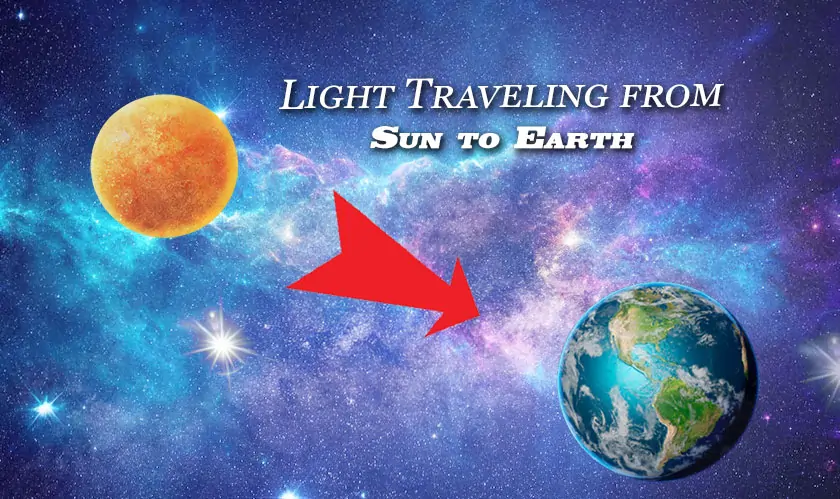Home Industry Space How Long Does It Take Light to...
Space

CIO Bulletin
21 June, 2024
Imagine a journey so swift and breathtaking that it spans the vastness of space in mere minutes: this is the extraordinary voyage of light from our Sun to Earth. At the heart of this cosmic adventure lies the speed of light, nature’s fastest traveler zooming through the void at an astonishing 300,000 kilometers per second.
From the moment photons, the tiny particles of light, burst forth from the Sun’s fiery core, their mission begins. Traveling across a staggering 93 million miles, they bring with them the essence of our star's energy and warmth. What's even more incredible is that this journey takes just over 8 minutes to complete, reaching our planet in a blink of an eye relative to the vastness of space.
This journey of light is not just a scientific marvel; it’s a crucial thread in the tapestry of our existence. It shapes our days, powers our ecosystems, and fuels our imaginations about the cosmos. Understanding how quickly light reaches us from the Sun isn’t just about numbers and calculations—it’s about grasping the wonder of our universe and how intimately connected we are to the celestial bodies that surround us.
To understand how long it takes light to travel from the Sun to Earth, one must first grasp the concept of the speed of light. The speed of light in a vacuum is approximately 299,792 kilometers per second (km/s), often rounded to 300,000 km/s for simplicity. This speed is a fundamental constant in the universe, denoted by the symbol 'c.' The speed of the light underpins much of modern physics, particularly the theory of relativity. It approximately takes about 499 seconds, or roughly 8 minutes and 20 seconds, for light to travel from the Sun to Earth.
Light consists of photons, which are elementary particles responsible for carrying solar radiation. The photon journey from the Sun to Earth begins at the Sun’s core, where nuclear fusion reactions generate vast amounts of energy. This energy eventually makes its way to the Sun’s surface and then radiates out into space.
The Earth's orbit around the Sun is not a perfect circle but an ellipse. As a result, the distance between the Sun and Earth varies throughout the year. The closest point in this elliptical orbit is called the perihelion, and the farthest point is called the aphelion.
During perihelion, the Sun-Earth distance is about 147.1 million kilometers, whereas, during aphelion, it is approximately 152.1 million kilometers. These variations slightly affect the light travel time. At perihelion, light takes about 8 minutes and 9 seconds to reach Earth, while at aphelion, it takes around 8 minutes and 27 seconds.
Solar radiation is the emission of energy from the Sun in the form of electromagnetic waves. This radiation includes visible light, ultraviolet light, and infrared radiation, all of which travel at the speed of light. The Sun's energy is essential for life on Earth, driving weather patterns, climate, and providing the energy necessary for photosynthesis in plants.
Albert Einstein's theory of relativity revolutionized the understanding of space and time. According to relativity theory, the speed of light is the same for all observers, regardless of their relative motion. This concept is crucial in explaining various astronomical phenomena and plays a vital role in understanding how light travels through the cosmos.
The time it takes for light to travel from the Sun to Earth has practical implications in various fields, including astronomy, communication, and space exploration. For instance, when scientists observe solar events, such as solar flares, they are witnessing events that occurred 8 minutes and 20 seconds earlier. This delay must be accounted for in real-time observations and communication with space probes.
The slight variations in the Sun-Earth distance due to the elliptical orbit have a minimal impact on light travel time. However, these differences are essential for precise astronomical measurements and for understanding the dynamics of the Earth’s orbit.
The journey of a photon from the Sun's core to its surface can take thousands of years due to the dense and turbulent nature of the Sun's interior. Once a photon escapes the surface, its travel time to Earth is relatively short, taking just over 8 minutes. This journey illustrates the complexity and scale of astronomical processes.
Understanding light travel time is crucial for space exploration. When missions are sent to other planets or spacecraft are deployed in deep space, communication signals, which also travel at the speed of light, experience delays. These delays must be considered in mission planning and operations to ensure accurate and effective communication with distant spacecraft.
Solar radiation and the light travel time from the Sun significantly influence Earth's climate and weather patterns. The energy from the Sun drives atmospheric circulation, ocean currents, and the hydrological cycle, affecting everything from daily weather to long-term climate trends.
The principles of light travel are applied in various technologies, including GPS systems, which rely on the precise timing of signals traveling at the speed of light. Similarly, telecommunications and internet infrastructure depend on the predictable speed of light for data transmission through optical fibers.
Conclusion
The travel of light from the Sun to Earth is a remarkable phenomenon that encapsulates the wonders of physics and astronomy. The consistent speed of light, the varying Sun-Earth distance, and the implications of light travel time are all integral to our understanding of the universe. From the photon journey beginning in the Sun's core to the impact of solar radiation on Earth's climate, the science behind light travel offers a profound appreciation of the interconnectedness of cosmic and terrestrial processes.
In conclusion, the journey of light from the Sun to Earth, taking approximately 8 minutes and 20 seconds, is a testament to the intricate dance of celestial mechanics and physical constants. As humans continue to explore and understand the universe, the principles of light travel remain a fundamental cornerstone of our scientific knowledge.
FAQs:
1. How fast does light travel from the Sun to Earth?
Light travels at approximately 300,000 kilometers per second (km/s). It takes about 8 minutes and 20 seconds for light to travel from the Sun to Earth.
2. What role does the Earth's elliptical orbit play in light travel time?
The Earth's orbit around the Sun is elliptical, varying between 147.1 million kilometers (perihelion) and 152.1 million kilometers (aphelion). Light takes about 8 minutes and 9 seconds at perihelion and about 8 minutes and 27 seconds at aphelion to reach Earth.
3. How does solar radiation from the Sun impact life on Earth?
Solar radiation includes visible light, ultraviolet light, and infrared radiation emitted by the Sun. It drives weather, influences climate, and sustains life through photosynthesis in plants.
4. Why is the speed of light considered a universal constant?
The speed of light, approximately 300,000 km/s in a vacuum, remains constant regardless of the observer's motion or light source. It's a foundational concept in physics, enabling precise calculations in astronomy and technology development.
5. What practical applications does understanding light travel time have?
Understanding light travel time is crucial for space exploration and communication. It allows scientists to observe solar events with an 8-minute delay and enables technologies like GPS that rely on accurate timing and positioning based on the speed of light.







